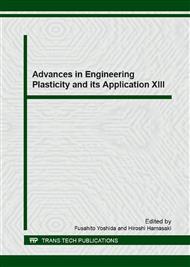[1]
M. Takiguchi, F. Yoshida, Plastic bending of adhesive-bonded sheet metals, J. Materials Processing Technology, 113 (2001) 743-748.
DOI: 10.1016/s0924-0136(01)00637-9
Google Scholar
[2]
M. Takiguchi, F. Yoshida, Deformation characteristics and delamination strength of adhesively bonded aluminium alloy sheet under plastic bending, JSME Int. J., Ser. A, 46, No. 1 (2003) 68-75.
DOI: 10.1299/jsmea.46.68
Google Scholar
[3]
M. Takiguchi, F. Yoshida, J. Materials Processing Technology, Analysis of plastic bending of adhesive-bonded sheet metals taking account of viscoplasticity of adhesive, 140 (2003) 441-446.
DOI: 10.1016/s0924-0136(03)00744-1
Google Scholar
[4]
M. Takiguchi, F. Yoshida, Effect of forming speed on plastic bending of adhesively bonded sheet metals, JSME Int. J., Ser. A, 47, No. 1 (2004) 47-53.
DOI: 10.1299/jsmea.47.47
Google Scholar
[5]
M. Takiguchi, S. Izumi, F. Yoshida, Rate-dependent shear deformation of ductile acrylic adhesive and its constitutive modeling, J. Mechanical Engineering Science, 218, Part C (2004) 623-629.
DOI: 10.1243/095440604774202268
Google Scholar
[6]
M. Takiguchi, T. Yoshida, F. Yoshida, Elastic-plastic bending deformation of adhesibely bonded sheet metals in tesile lap shear tests with special reference to effect of tesile speed, Key Engineering Materials, 274-276 (2004) 805-810.
DOI: 10.4028/www.scientific.net/kem.274-276.805
Google Scholar
[7]
T. Yoshida, M. Takiguchi, F. Yoshida, Strength of highly ductile acrylic adhesive in butt-joint under combined tension and torsion, Key Engineering Materials, 274-276 (2004) 993-998.
DOI: 10.4028/www.scientific.net/kem.274-276.993
Google Scholar
[8]
M. Takiguchi, F. Yoshida, Effect of loading speed and shear prestrain on adhesive fatigue strength in single-lap joint, Key Engineering Materials, 340-341 (2007) 1479-1484.
DOI: 10.4028/www.scientific.net/kem.340-341.1479
Google Scholar
[9]
T. Yoshida, T. Oishi, M. Takiguchi, F. Yoshida, Viscoplastic behavior of acrylic adhesive in butt-joint at various temperatures under complex loading : Experimentation and modelling, Key Engineering Materials, 340-341 (2007) 1485-1490.
DOI: 10.4028/www.scientific.net/kem.340-341.1485
Google Scholar
[10]
M. Takiguchi, T. Yoshida, F. Yoshida, Effects of temperature and forming speed on plastic bending of adhesively bonded sheet metals, Int. J. Modern Physics B, 22-31/32 (2008) 6253-6258.
DOI: 10.1142/s021797920805187x
Google Scholar
[11]
T. Tokuda, T. Yoshida, M. Takiguchi, M. Funaki, N. Mizutani, F. Yoshida, Viscoplastic behavior of highly ductile acrylic adhesive under cyclic torsion and its modelling, Ploc. 10th Int. Conf. Thecn. Plast. (ICTP2011), (2011) 990-994.
DOI: 10.11618/adhesion.49.441
Google Scholar
[12]
M. Takiguchi, T. Yoshida, M. Funaki, F. Yoshida, Effects of thicknesses of sheet and adhesive layer on plastic-bending of adhesively bonded sheet metals, Key Engineering Materials, 535-536 (2013) 381-384.
DOI: 10.4028/www.scientific.net/kem.535-536.381
Google Scholar
[13]
M. Takiguchi, T. Tokuda, T. Yoshida, M. Funaki, H. Hamasaki, F. Yoshida, Plastic-bending of adhesively bonded dissimilar sheet metals, Key Engineering Materials, 535-536 (2013) 418-421.
DOI: 10.4028/www.scientific.net/kem.535-536.418
Google Scholar
[14]
M. Takiguchi, T. Tokuda, T. Yoshida, T. Uemori, F. Yoshida, Die-bending of Adhesively Bonded Sheet Metals, Key Engineering Materials, Vol. 626 (2015) 103-108.
DOI: 10.4028/www.scientific.net/kem.626.103
Google Scholar
[15]
Y. Tsuchiya, I. Higuchi, Stress and Strength of a Laminated Composite Plate Subjected to Bending Moments, The Japan Wood Research Society, Vol. 59, No. 3 (2013)128-137.
DOI: 10.2488/jwrs.59.128
Google Scholar


